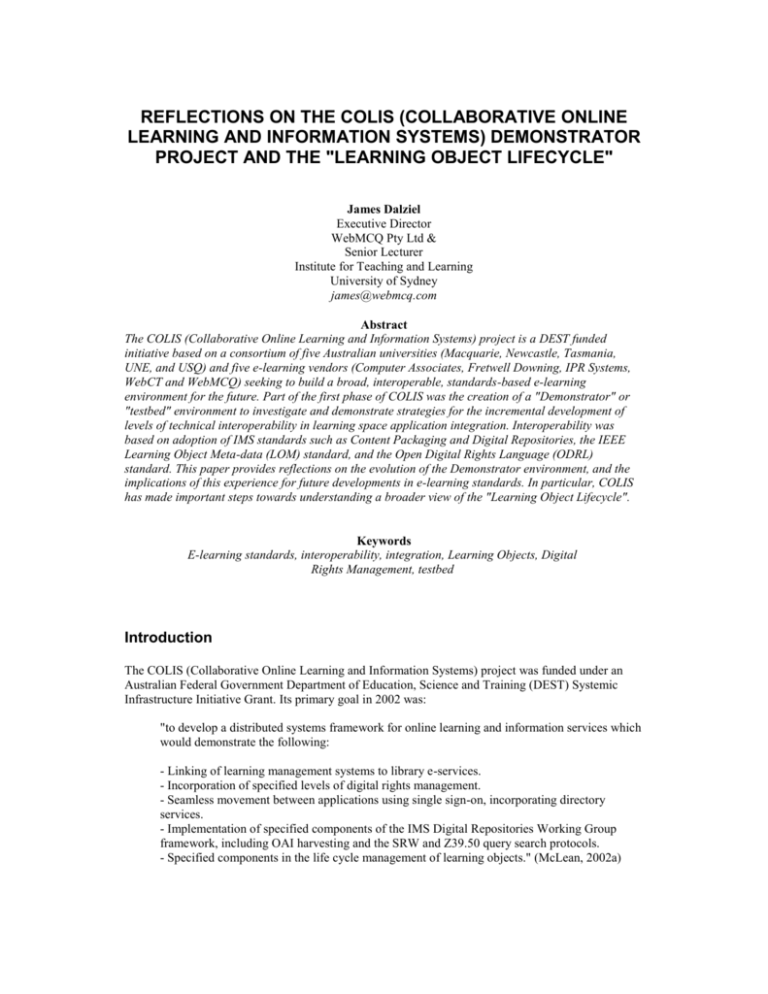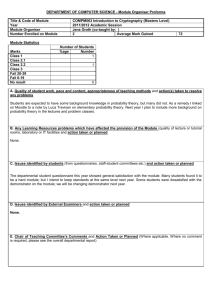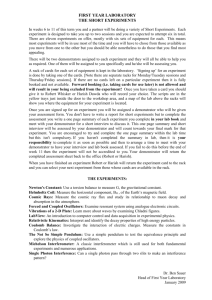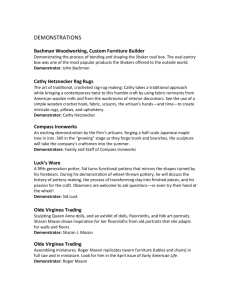Reflections of the COLIS (Collaborative Online Learning
advertisement

REFLECTIONS ON THE COLIS (COLLABORATIVE ONLINE LEARNING AND INFORMATION SYSTEMS) DEMONSTRATOR PROJECT AND THE "LEARNING OBJECT LIFECYCLE" James Dalziel Executive Director WebMCQ Pty Ltd & Senior Lecturer Institute for Teaching and Learning University of Sydney james@webmcq.com Abstract The COLIS (Collaborative Online Learning and Information Systems) project is a DEST funded initiative based on a consortium of five Australian universities (Macquarie, Newcastle, Tasmania, UNE, and USQ) and five e-learning vendors (Computer Associates, Fretwell Downing, IPR Systems, WebCT and WebMCQ) seeking to build a broad, interoperable, standards-based e-learning environment for the future. Part of the first phase of COLIS was the creation of a "Demonstrator" or "testbed" environment to investigate and demonstrate strategies for the incremental development of levels of technical interoperability in learning space application integration. Interoperability was based on adoption of IMS standards such as Content Packaging and Digital Repositories, the IEEE Learning Object Meta-data (LOM) standard, and the Open Digital Rights Language (ODRL) standard. This paper provides reflections on the evolution of the Demonstrator environment, and the implications of this experience for future developments in e-learning standards. In particular, COLIS has made important steps towards understanding a broader view of the "Learning Object Lifecycle". Keywords E-learning standards, interoperability, integration, Learning Objects, Digital Rights Management, testbed Introduction The COLIS (Collaborative Online Learning and Information Systems) project was funded under an Australian Federal Government Department of Education, Science and Training (DEST) Systemic Infrastructure Initiative Grant. Its primary goal in 2002 was: "to develop a distributed systems framework for online learning and information services which would demonstrate the following: - Linking of learning management systems to library e-services. - Incorporation of specified levels of digital rights management. - Seamless movement between applications using single sign-on, incorporating directory services. - Implementation of specified components of the IMS Digital Repositories Working Group framework, including OAI harvesting and the SRW and Z39.50 query search protocols. - Specified components in the life cycle management of learning objects." (McLean, 2002a) These goals arise from a vision of a broadly-based interoperable learning application environment which goes beyond simply considering the use of a Learning Management System. This broader environment is sometimes discussed in relation to an institutional portal (eg, Olsen, 2002). In the UK, the term "Virtual Learning Environment" (VLE) has been used for the narrow "LMS" area, whereas "Managed Learning Environment" (MLE) is understood to encompass a wider range of functions beyond LMS, such as Library systems and Student Information Systems (Lay, 2002). It appears likely that the broader issues of the Managed Learning Environment (rather than simply VLE issues) will dominate the next stage in the evolution of online learning within higher education and similar sectors, hence the importance of the COLIS project. The roles of the five vendors within COLIS give an indication of the broader challenges ahead for MLEs in terms of dealing with a wider scope of systems and issues. The roles were: Computer Associates: Single-sign-on, portal, directory services Fretwell Downing; Library e-reserve and distributed search gateway IPR Systems: Learning Object Trading Exchange WebCT: Learning Management System WebMCQ: Learning Object Management System (sometimes called a Learning Content Management System, IDC, 2001) It is worth noting the broad scope of this project compared to other major international projects in learning application system integration (such as the MIT Open Knowledge Initiative Project, OKI, 2001). Of particular importance is the integration of both "LMS" and "Library system" worldviews within a single environment, and the incorporation of Digital Rights Management with Learning Objects. A key point regarding the operation of the COLIS Demonstrator is that there was no single dominant vendor. Some successful integration projects (to date) have relied on requiring all additional systems to conform to the functionality of a single dominant system (such as the LMS). While this may assist progress towards a practical, short-term outcome in a given institution, it presents problems for the future due to a lack of "substitutability", particularly in relation to the dominant system (ie, the process of swapping one LMS for another becomes very difficult when integration with all surrounding systems is based on unique integration protocols required by the original LMS). The COLIS Demonstrator took the more difficult approach of attempting systems integration via abstracted, standards-oriented approaches (where possible). The role of the universities during the "Demonstrator" phase was to provide feedback on the appropriateness of the overall environment arising from integration of the vendor systems. This feedback was led by Macquarie University, in conjunction with the other four university partners. A parallel project on university IT architectures was conducted by all five universities (see www.colis.mq.edu.au for further details). Initial Demonstrator Environment Descriptions The first attempt at an overview diagram of the COLIS environment was produced in early 2002 (McLean, 2002b), and indicated the complexity of relationships involved. COLIS Phase 1 Project Scenario We bMCQ ContentP ac ka IPR System s ge Cre ator FDi? Web ContentCr ea tor Out of Scop e Aut hor Lea rning Ob ject s Aut hor L ear ning Object /Cont ent Pack age Met ada ta Cre ate Co nte nt Pack age Cont ent Mana gemen t Digit al Rig hts Mana gemen t DR Ma na ge r Digit al Rig hts Met adat a Lea rning Object /Cont ent Pack age Met adat a XML Que ry Lea rning Ob je ct/ Cont ent Pack age Reposit ory WebCon ten t Met adat a Repo sitor y XML Que ry WebCon ten t Met adat a Repo sitor y Z39 .5 0 Ext er nal Supp lier s Sea rch Ga tewa y & R equ est /De live r E- res our ce Rep osit ori es eg : Docu ment s E- Jour nals Aut hor Lea rning Unit s Web Reso ur ces Lea rning Ma nage ment and De live ry Env iron ment Infos ee ke Unified Po rt al inc. Single Use r Signo n , Acce ss Mana gemen t Cour se U nitC re ator Le ar ne r We bCT Audit Us age Digit al Rig hts Multi media Ob ject s r E- Reso ur ce Met adat a Reposit ory XML Z39.50 E- Reso ur ce Met adat a Rep osit ory XML Quer y Lea rning Ob je ct Met ada ta Rep osit ory XML Quer y CA Anyone Peop le Dir ect or ie s /Aut hen ti cat ion Ser vices A similarly complex architecture diagram had been produced by the Digital Repositories working group of IMS, which also informed the initial development of the Demonstrator environment (IMS, 2002). This diagram illustrates the fact that although search and retrieval issues may be at the centre of the "digital repositories picture", there are many more general questions which wrap around these issues, such as trading/procurement, directories and access management, and the various types of repositories. The e-learning-related standards/specifications used in the Demonstrator project were as follows: IMS Content Package IEEE Learning Object Meta-data (LOM) IMS Digital Repositories working group materials Open Digital Rights Language More general integration standards such as SOAP/WSDL were not considered sufficiently robust to provide a basis for system communication, although these are worthy of further exploration in the future as they mature. It should be acknowledged that no widely accepted standard for Single-Sign-On exists at present, which proved a significant challenge for the project. FDI Based on the context described above, each vendor was requested to provide an outline of their areas of expertise, and "use cases" to describe how users of their systems would act, and how these actions would interoperate with other systems. This process was initially conducted individually by the vendors, and once finalised, each vendor scenario was shared with the rest of the group. This led to collaborative development of a shared view of the Demonstrator environment, its components, and system interactions (developed on an iterative basis among the vendors and COLIS project management staff). The author's main role in this process was in producing a "global use case" for COLIS (see below), and in describing the operation of the DRM-enabled Learning Object Management System (LOMS), and its connection to trading, delivery and access/identity management (ie, SSO) systems. Demonstrator Challenges From the author's perspective, a number of key issues emerged during the scenario-development process described above. The first, and most fundamental, was the difficulty of finding a common language for discussion. Many fundamental terms (such as "Learning Object", "Single-Sign-On", "interoperability", and "integration") appeared to have widely varying interpretations among the participants, which made finding a shared understanding of the Demonstrator environment (ie, a "global use case") a significant challenge. It is interesting to note that in the April IMS meeting in Boston (2002), a similar attempt at developing shared use cases had very similar difficulties around language and definitions. This suggests that clarification of terms is still a fundamental issues for elearning standards development. Another key issue was the difference between e-learning and library worldviews, and the challenges of integrating these perspectives into a coherent framework which draws from the strengths of each field. For the author (who comes from an e-learning background), it was interesting to note that certain current challenges for e-learning (such as finding a way of expressing both physical and virtual resources using a single language) have parallels in the library world, sometimes with over a decade of theoretical development which is largely unknown to e-learning researchers (McLean, 2002c). A third key area was the incorporation of Digital Rights Management (DRM) with Learning Objects. COLIS represents one of the first applications of an open, freely available digital rights expression language to Learning Objects. In practical terms, this uncovered a number of significant challenges, such as the need for Single-Sign-On (ie, access and identity management) throughout the environment in order to be able to implement the licence requirements of an ODRL agreement at all stages of the lifecycle of creation, trading, downloading, arranging and student use of Learning Objects. One of the outcomes of the COLIS project as a result of this component of work is a number of "education market specific" ODRL licence templates (see Ianella, 2002), covering issues such as volume and site licences for Learning Objects in educational settings. The fourth, and probably most difficult area, was the cluster of issues around Single-Sign-On, portals, authentication, authorisation and directories. All of these issues involve some aspect of identity management - knowing who a user is, and what they are permitted to do. These issues linked closely to DRM, although additional problems included those arising from "cross-linking" between Demonstrator environment systems without returning to the portal (while retaining automated single-sign-on without significant modification to vendors systems). The difficulties experienced in this area suggest the need for a specific project on this cluster of issues so as to provide a number of different potential SingleSign-On approaches according to different system and institutional needs. There would be significant value in a unified Single-Sign-On system capable of several conceptually differently approaches to resolving SSO challenges (ie, "multi-modal SSO"). Finally, it should be noted that COLIS anticipated two phases, an initial, simple integration based on a small number of standards, followed by a more complex integration based on as many interoperable standards as possible. In practice, the task of gaining agreement for the first phase was a significant challenge in its own right, and involved more integration than was initially envisaged. As a result, any future "phase 2" of COLIS will require considerable additional time and funding to fully explore the technical and interoperability issues uncovered during "phase 1". In terms of project scoping, an important early challenge during the scenario development stage was to decide which areas of interoperability to pursue in phase 1, and which were better left until phase 2. Demonstrator Scenarios The finalised scenarios for the Demonstrator were as follows: General • All actions to take place within a Single-Sign-On environment Teacher actions Search for Learning Object (LO) in Learning Object Exchange, accept licence terms, download Install LO(s) in Learning Object Management System, manage LOs, prepare for LMS Use federated search gateway for search of LOs and other resources meta-data Create link to LOs in LMS course area Student actions Login to LMS, go to relevant course, access link to LOs Learning Object Management System processes ODRL licence requirements and student details, and: Presents LO, or Presents usage agreement, or Denies access Track/Audit student access to LOs against licence limitations To place these scenario requirements in a broader context, the author of this article adapted a "global use case" developed for the Boston IMS meeting, and incorporated the above actions into this diagram, together with a listing of the relevant COLIS vendor for each step (see diagram over). From the author's perspective, this global use case exercise uncovered two new areas of further work for the COLIS project in its vision of a broadly-based learning application environment. These were: (1) the role of objectives, assessment and records; and (2) the need for "learning activities", not just "learning content", in the use of Learning Objects. These two areas are described further below. COLIS Global Use Case: Phase 1 Overview Autho rity C re ato r Arra ng er Info se ek er Le arne r C OLIS pa rticipan t Universities Pr es cr ib e Author Academics (Out of scope) Sub mit to LOX IPR S Des ign Lear ning Activity WebCT / WebMCQ Sear ch LOX Sear ch via Gateway Review Licence Review Meta-data Download LOs Obtain Link s IPR S / FD i IPR S / FD i IPR S / FD i Stru ctur e LOs & Activitie s WebCT/WebMCQ Stru ctur e Ass es sment Academics (Out of scope) Org anis e Student Roles/Gro ups ? Student Login Student Searches Do Lear ning Do Ass es sment CA WebCT / WebMCQ / FD i Academics (Out of scope) Recor d Universities (1) Objectives, Assessment and Records The central COLIS Demonstrator focus was on interoperability among e-learning and library systems, but there needs to be a context in which this interoperability is relevant. This requires acknowledgment of some kind of "authority" which prescribes learning objectives or outcomes, which then form the basis for all creation and arranging of learning materials. In higher education in Australia, this role is played by individual universities, which are self-accrediting. In the Australian VET sector, the authority is a central government body which defines competencies within a generalised training framework. Regardless of the mode of operation of the authority, its role is important for a complete global use case, as this affects not just the "prescribing" end of the spectrum (prior to learning), but it impacts on the type and methods of assessment required, and the ways in which assessment results are reported and recorded by the authority. In relation to competencies, the IMS has recently "re-activated" the previously defunct "Competencies" working group, as it is increasingly recognised that some description of objectives/competencies/etc is a fundamental requirements for a complete set of e-learning standards. (2) Learning Activities versus Learning Content There is considerable confusion around the meaning of the term "Learning Object", and much of this relates to the highly "content-centric" view of Learning Objects which is dominant in the corporate training world of e-learning. While not wishing to debate the appropriateness or otherwise of this approach in corporate training here, it is clear that education sector e-learning requires a much more sophisticated educational model which incorporates multi-user "learning activities", rather than simply (single user) content. These activities may be the use of a chat room, discussion board, assessment system, etc. In many cases, these activities require more than one learner, which suggests a different type of e-learning standard to those applicable to corporate training. The most promising work in this area is "Educational Markup Language" (EML) from the Open University of the Netherlands (Koper, 2001), which has subsequently been adopted by the Learning Design working group of IMS (IMS, 2002b). EML describes both learning content and learning activities, and provides for multi-user, multi-role environments. While beyond the scope COLIS phase 1, it is clear than any comprehensive future e-learning environment for a university will need to deal with the issues raised by EML/Learning Design. In this author's opinion, Learning Objects (as currently understood) should be divided into three "tiers" as follows: Digital Assets: the lowest level of files such as text, HTML, images, etc. These files may be static, or dynamically re-useable (in the sense that their operation may be adapted for different contexts or user requirements - such as flexible Flash exercise "shells", see Dolphin & Miller, 2002, or multiple output format rendering via Content Management System functionality for HTML, print, PDAs, etc) Learning Objects: learning content which has stand-alone educational value (often associated with a single competency/objective/outcome/etc), based on one or Digital Assets Learning Activities: the highest level - based on activities and tools such as discussion groups and chat rooms, which may incorporate one or more Learning Objects. Given this structure, "Learning Objects" may be defined more narrowly as follows: A Learning Object is an aggregation of one or more digital assets, incorporating meta-data, which represent an educationally meaningful stand-alone unit (Dalziel, 2002) This three tiered structure is represented in the diagram below. It illustrates the fact that several Digital Assets may be combined to form a Learning Object (as well as re-used in other Learning Objects), and that one or more Learning Objects may be used for a Learning Activity. In addition, two (or more) Learning Objects may be chained together to create a "Learning Object Sequence", as can two (or more) Learning Activities, to create a "Learning Activity Sequence" (see the horizontal dotted lines). The central advantage of this approach is that it allows for greater clarity in specifying the different elements of re-useability in e-learning, and gives the term "Learning Objects" a more narrowly focussed (and hence hopefully more useful) meaning. The Learning Object Lifecycle As the global use case suggests, there is more to Learning Objects than simply their creation and storage in a database. Following creation, Learning Objects must be submitted to an appropriate Learning Object Exchange where issues such as licences and rights management are handled. These issues can arise even if the item is intended for free use, if for no other reason than to avoid the risk of inappropriate commercial sale of the free public domain items. Following storage of a "DRM-enabled" Learning Object, there is an important search and retrieval stage which can be based on federated searching across many different databases, with exposed metadata to allow for structured searches. Having found an appropriate object, the licence conditions associated with the object must be reviewed and accepted if the teacher wishes to use the object. Most importantly, the delivery system into which the Learning Object is placed for delivery to students must allow for the processing of the digital rights expressed in the associated licence. This involves the ability to read and interpret the XML-based licence conditions specified in a digital rights expression language like ODRL. To date, no educational system appears to have dealt with this issue in an open, standards-oriented way, so the COLIS Demonstrator provides a unique perspective on this issue. At the time of delivery of Learning Objects to students, the presentation of an end-user licence agreement may be required, with students only permitted to view the object if they accept the end-user agreement. At an aggregate level, the Learning Object Management System needs to be able to create an audit report of usage of the Learning Objects by students tracked against the ODRL licence requirements (so as to avoid any licence infringement). Where access to the Learning Object is via a link embedded in the LMS (as in COLIS), this link from LMS to LOMS must operate within a SingleSign-On environment (or equivalent) so as to track individual user access to objects (required for tracking of volume-based licences). Finally, Learning Object creators and arrangers may want the freedom to modify items, and then resubmit these to a Learning Object Exchange for use by others. This requires a high degree of sophistication in the digital rights expression language to allow it to cope with multi-party agreements based on modified items. However, it appears that ODRL is well placed to support this activity, hence a future COLIS project may investigate the practicalities of allowing teachers to trade and modify Learning Objects within a DRM framework. Summary The COLIS project has provided an example of the future of integrated learning application environments, based on interoperable standards. Notable achievements of this environment include some harmonisation of LMS and Library system approaches, the implementation of DRM (and the creation of sample education sector ODRL licences), the use of DRM with Learning Objects at the "delivery" end of the "Learning Object Lifecycle", and the use of a standards-oriented federated search gateway. COLIS has also uncovered many issues for further exploration in the future, such as challenges associated with Single-Sign-On, use of SOAP/WSDL for integration, exploring standardsbased approaches to multi-person learning activities, describing objectives and assessment in standards oriented ways, and the practicalities of modification and re-use of tradeable Learning Objects. Without doubt, there is much to be done. References Dalziel, J. R. (2002). COLIS Demonstrator: Project and Industry Scenarios. Presentation for COLIS Workshop, Macquarie University. [Online]. Available: http://www.colis.mq.edu.au/projects/demo_jul02.ppt [2/8/02] Dolphin, I. & Miller, P. (2002). Learning Objects and the Information Environment. Ariadne, 32. [Online]. Available: http://www.ariadne.ac.uk /issue32/iconex/ [15/7/02] Ianella, R. (2002). COLIS ODRL profile. [Online]. Available: http://www.iprsystems.com/COLIS/COLIS-ODRL-Profile-04.pdf [2/8/02] IDC (2001). Learning Content Management System: A New eLearning Market Segment Emerges. [Online]. Available: http://www.wbtsystems.com/idc/ [12/2/02] IMS, (2002a). Digital Repositories Working Group. [Online]. Available: http://www.imsproject.org/digitalrepositories/index.cfm [8/8/02] IMS, (2002b). Learning Design Working Group. [Online]. Available: http://www.imsproject.org/learningdesignteam.html [8/8/02] Koper, R. (2001). From change to renewal: Educational technology foundations of electronic environments. EML website. [Online]. Available: http://www.eml.ou.nl/ [ 30/4/01] Lay, N. (2002). Review of VLEs and MLEs for UK Library Network. McLean, N. (2002a). COLIS Demonstrator Project Press Release. [Online]. Available: http://www.colis.mq.edu.au/projects/demo_pr_jul02.pdf [22/7/02] McLean, N. (2002b). COLIS Update. Presentation for COLIS Workshop, Macquarie University. [Online]. Available: http://www.colis.mq.edu.au/projects/prog_rep_jul02.ppt [10/8/02] McLean, N. (2002c). Personal communication, February, 2002. OKI, (2001). Open Knowledge Initiative Overview. COLIS Website. [Online]. Available: http://www.colis.mq.edu.au/projects/initiative.htm [10/8/02] Olsen, F. (2002). The Power of Portals: More colleges create Web services that can be customized to help students and professors. The Chronicle of Higher Education, 48, A32. [Online]. Available: http://chronicle.com/free/v48/i48/48a03201.htm [10/8/02] NB: The opinions presented here are those of the author alone, and should not be assumed to represent the views of other participants in the project. Copyright 2002 James Dalziel. The author(s) assign to ASCILITE and educational non-profit institutions a non-exclusive licence to use this document for personal use and in courses of instruction provided that the article is used in full and this copyright statement is reproduced. The author(s) also grant a non-exclusive licence to ASCILITE to publish this document in full on the World Wide Web (prime sites and mirrors) and in printed form within the ASCILITE 2002 conference proceedings. Any other usage is prohibited without the express permission of the author(s). Publication Details: Dalziel, J. (2002). Reflections on the COLIS (Collaborative Online Learning and Information Systems) Demonstrator project and the "Learning Object Lifecycle". In A. Williamson, C. Gunn, A. Young & T. Clear (Eds), Winds of Change in the Sea of Learning: Proceedings of the 19th Annual Conference of the Australasian Society for Computers in Learning in Tertiary Education. Auckland, New Zealand: UNITEC Institute of Technology.


